The U.S. equities markets do not look pretty after this week’s steep decline. However, while there are dark clouds over the market, especially in high PE multiple growth stocks, the sun could peek out before too long.
The Clouds That Rained On Markets Last Week Formed A While Back
You might recall our Market Outlook from Nov. 21, 2021, titled “Something Stinks.” In it, we highlighted prescient market messages such as…
“Most noteworthy is that both market internals and market sentiment eroded despite two US equity benchmarks hitting new all-time highs this week.”
And Mish’s observation that...
“This past week the market found both love and irreconcilable differences. The love came from the big cap tech stocks. NVIDIA (NASDAQ:NVDA), Apple (NASDAQ:AAPL), Google (NASDAQ:GOOGL), Microsoft (NASDAQ:MSFT) all gave investors hearts and flowers. On the flip side, small caps, energy, industrial metals, and transportation stocks gave investors indigestion, inconveniently ahead of Thanksgiving.”
These conditions often foreshadow seemingly harmless pullbacks that escalate into the ugly, rapid sell-off conditions we experienced last week. Not surprisingly, the real carnage was led by both the aforementioned small cap index Russell 2000, (IWM) and the big cap tech NASDAQ 100, (QQQ).
In fact, 2022 has been the NASDAQ 100’s worst-performing January since 2008, and as you read below, the broader NASDAQ Composite index is on pace to have its worst January performance ever.
The NASDAQ is down 12% from its highs for the first time since Mar. 9, 2020, and…
More significantly, it closed below the institutionally respected support level of the 200-day moving average shown in green in the chart of the QQQ below.
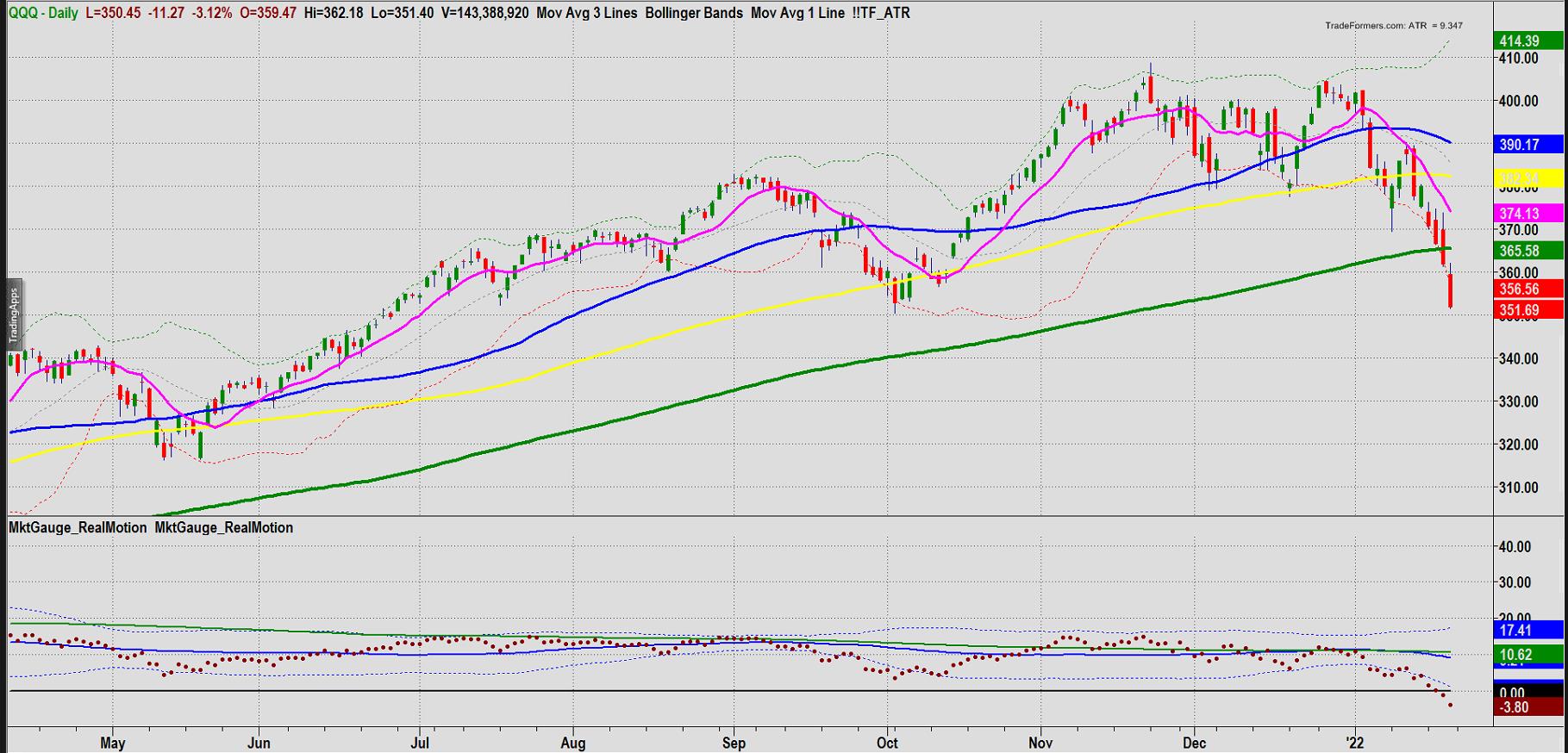
What’s Next?
As the table below shows, when drops greater than 5% happen in January, further downside has occurred in the short-term. However, three months later tends to yield a rebound. Of course, the sample size is small.
In 2008, the index was down 9.89% and ended the year down over -38%, however, in 2009 the index started off down 6.38% and ended the year up 45%. Pick your poison.

In the chart below, you can see how every January performed for the last 50 years in the NASDAQ Composite with a semi-log scaled chart for perspective.
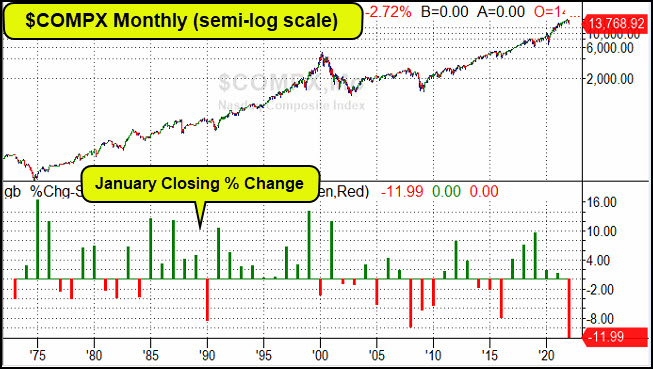
Here’s the same perspective for the S&P 500:
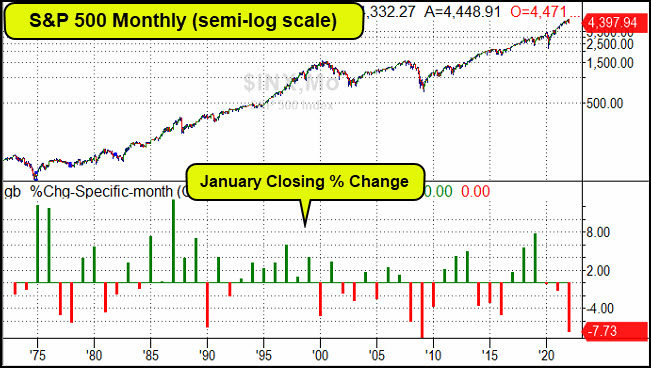
The S&P 500 is down about - 8% YTD and has fared better with a more diverse group of stocks and many in more value-oriented sectors. The sectors include energy, financials), and commodities.
Looking more closely, if you compare the Vanguard Value Index Fund ETF Shares (NYSE:VTV) to its Growth counterpart, Vanguard Growth Index Fund ETF Shares (NYSE:VUG), you will quickly see one of the widest disparities occurring in many years.
Value stocks are slightly down on the year, and growth stocks have been hammered. Sorry Cathie, you are wrong on this as value stocks are still close to 15+ year lows versus growth.
Meanwhile, the SPDR® S&P 500 (NYSE:SPY) is sitting right above its 50-week moving average, which is an important support level (see the blue line in the chart below).
As our own Mish has stated on national TV the past few days, we are more than likely “rangebound.” So, we might test but hold onto the longer-term trend and be at the bottom of the trough.
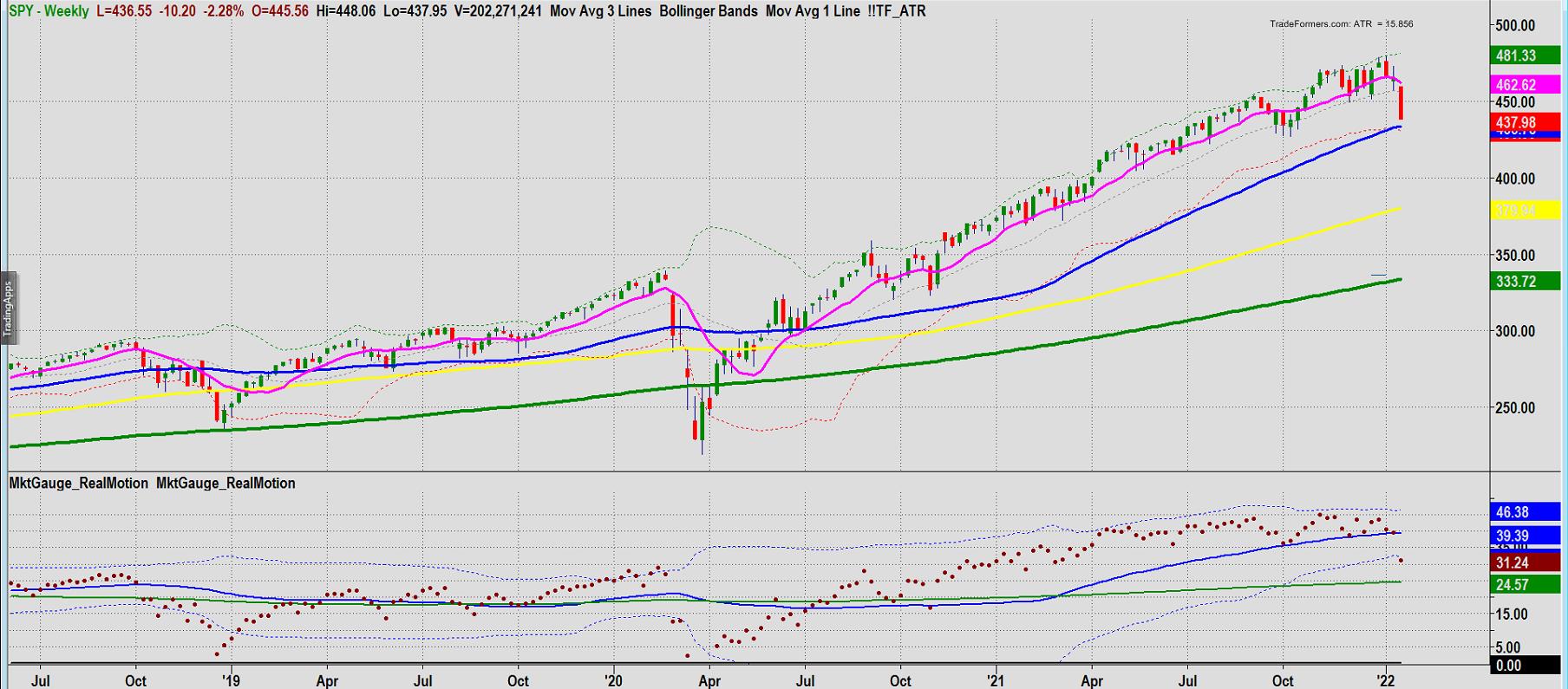
Probably the most damage has been done to small-cap stocks and the Russell 2000 index (IWM).
As Mish points out in her daily commentary (Mish’s Market Minute) using the Modern Economic Family, Grandpa Russell best represents manufacturing and small businesses in the US. Currently, this index is telling a story of an economic slowdown.
Perhaps due to the ongoing battle with COVID, higher trending inflation, or concern about how soon the Fed starts raising rates (which is expected to have a negative effect on borrowing costs for small businesses), the small company index is getting trounced.
Unfortunately, the chart of the IWM below indicates that things could get uglier.
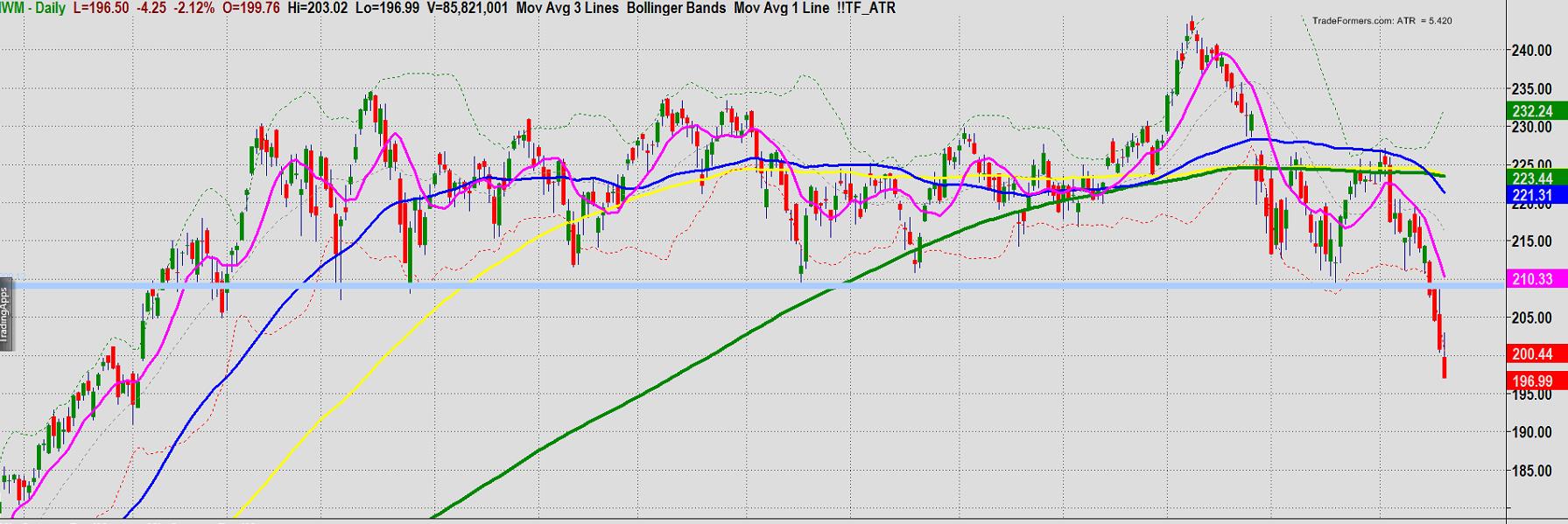
After being rangebound from February last year until year-end 2021 (with a short fake out rally in November), the small caps finally broke the range and fell 10% quickly last week.
7 Areas Of Optimism
But all is not lost. There are interesting pockets of opportunity and sunshine.
There are good reasons we remain optimistic about the economy and the markets. Several of these Mish discussed this week on National TV (see her Jan. 20 Bloomberg appearance here).
Here are 7 of our favorites for why we could see more sunshine peek out through the clouds very soon:
- Interest rates remain low. While the market is attempting to get its footing with respect to the end of Fed easing and potential interest rate raises coming soon, interest rates still remain very low on a relative basis and historically. Considering the recent market action, the Fed may have to back off from being as aggressive as the markets are anticipating, supporting equities, and postponing the inevitable for a future date. This could keep multiples from contracting too much.
- Earnings matters. Speaking of high multiples. It is expected that earnings of the S&P will rise between 15-20%. While there are likely going to be earnings misses and unforgiving investor behavior [we have already seen that with Netflix (NASDAQ:NFLX)], there will also be plenty of earnings beats. Over the next few weeks, the number of these could certainly pick up.
Rising labor and supply costs have been a harbinger of “bad news,” but some financial companies and potentially consumer-oriented companies [like Home Depot (NYSE:HD), Costco (NASDAQ:COST), and Walmart (NYSE:WMT)] could surprise and provide a short-term support level for the markets. - The Economy Is Expected to Grow This Year. Most economists expect the economy to grow by 4.0-4.5% GDP in 2022. This bodes well for continued economic expansion and little risk of a recession. If the Fed does raise rates, this is enough growth to put a net in any slowdown caused by higher rates. Plus, there are trillions in dollars in stimulus from Congress still waiting to find its way into the economy. The economy is also still going through a “restocking” which should help small businesses that were hurt by the COVID slowdowns and supply chain issues. All these factors should help keep a floor under the stock market.
- There is huge cash piling up on the sidelines. Seeing weakness in the markets, many active hedge funds and traders have been accumulating cash and sitting on the sideline. Once there is some stability and the downdraft has subsided, you may see this money quickly re-enter the market. We could see one heck of a rally soon. Also, we could see further market rotation with investors piling into value stocks which will give the broad market a lift (while keeping the tech heavy NASDAQ continuing to experience volatility).
- Market sentiment is starting to turn bearish. This is a contrarian indicator and typically signals that we may be getting closer to a turn in short-term positive buying. While this would be nice to see, it may have little bearing on long-term market health. See the AAII (American Association of Individual Investor) bullish/bearish chart below:
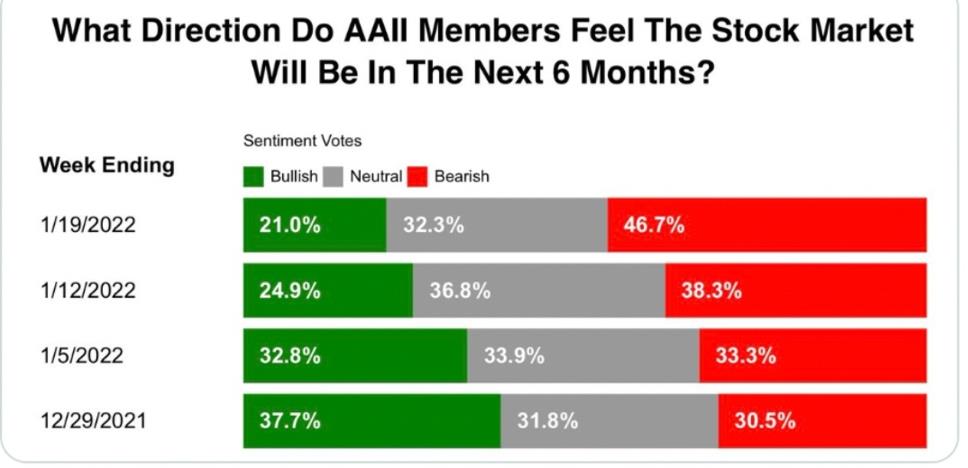
6. Midterm political cycle charts point to more favorable markets later this year. If we follow past midterm election years and when the White House is occupied by a Democratic President (in his second year), this type of market weakness early in the year is typical. However, the markets tend to trend up and are more positive after the first quarter. (See chart below)
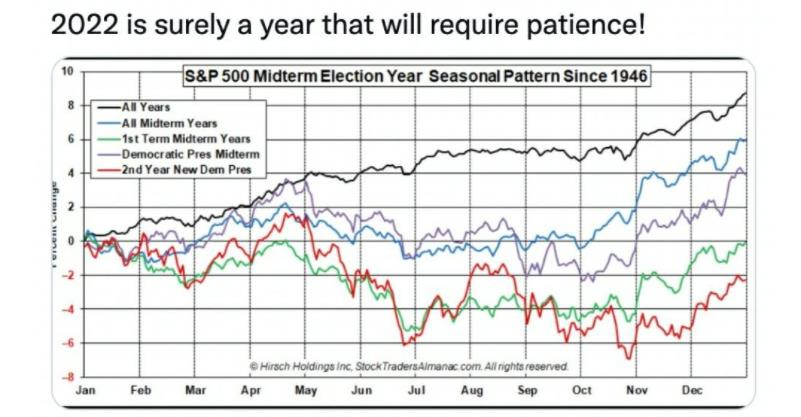
- COVID cases are slowing, finally. While most states are still reporting large numbers of COVID cases and a consistent level of hospitalizations, many states have begun to relay that they feel they are past the peak of Omicron cases. This bodes well especially since we are a few months away from warmer weather and people getting out. Many physicians and economists believe we could return to a normal environment in a few months. This would have a positive effect on the economy and the stock market.
Here are some additional observations from Big View that paint a more complete picture moving forward:
Risk On: Bullish
- SPY closed just above its 50-week moving average, the only index holding onto a long-term bullish phase
- Equity markets are very extended on the downside across all 4 key US equity indices, with both price and momentum according to Real Motion setting up for potential mean reversion on their daily charts…if you’re optimistic
- Regional Banks—SPDR® S&P Regional Banking ETF (NYSE:KRE) and Semiconductors—VanEck Semiconductor ETF (NASDAQ:SMH) are still hanging on above their rising 200-day moving averages
Risk Off: Bearish
- All key indices got smoked this week—SPY, IWM, QQQ, DIA—and now have negative TSI’s, all closing below their 200-day moving average and 3 of the 4 moving into warning phases (IWM moved to a bear phase)
- Volume patterns are showing some of the strongest distribution in recent memory across all major indices
- All sectors were down on the week led by spec sectors such as Consumer Discretionary XLY) and Semiconductors (SMH) while Consumer Staples (XLP), which is a risk-off play, was also down only -1.2%
- Oil (USO), Silver (SLV), and Commodities in general were strong on the week, along with volatility (VXX)
- Market Internals, of course, are weak, but they have not hit the extremes seen in March 2020, or equivalent to the two prior sell-offs in July and December 2021
- Risk Gauges are 100% Negative across the board and now in Risk-Off mode
- Cash Volatility (VIX.X) has broken out into a new bull phase and is approaching levels that we saw in late November/early December sell-off
- Moving averages are at oversold levels, but not the extremes we saw in March 2020
- The number of stocks above the 200-day moving average in the SPY has slipped below 50%
- The Long Bond—iShares 20+ Year Treasury Bond ETF (NASDAQ:TLT) was flat on the week and still closed in a warning phase, making the traditional flight-to-safety look a bit iffy while the Fed is being backed into a corner…fight inflation? Or support equities by not raising rates?
- Value stocks (VTV) continue to surge against Growth stocks (VUG), and there is no bubble (as stated by Cathie Wood), and the takeaway here is that the relative improvement does not necessarily mean that buying value is a good play either as everything could be taken down
- 3 of the 6 members of Mish’s Modern Family are in bear phases—SPDR® S&P Retail ETF (NYSE:XRT), IWM, iShares Biotechnology ETF (NASDAQ:IBB)
- Foreign equities across the board are dramatically outperforming US equities. However, they are also still under pressure and simply performing better on a relative basis
